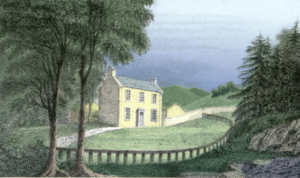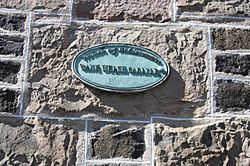Jane Welsh Carlyle facts for kids

Jane Baillie Carlyle (born Welsh; 14 July 1801 – 21 April 1866) was a Scottish writer. She was married to the famous writer Thomas Carlyle.
Jane Carlyle did not publish any books during her lifetime. However, many people thought she was an amazing letter writer. Virginia Woolf called her one of the "great letter writers." Another writer, Elizabeth Hardwick, said Jane's letters were like a "private writing career."
Contents
Life Story
Jane Baillie Welsh was born in Haddington, East Lothian, Scotland, on 14 July 1801. Her parents were Grace Caplegill and John Welsh.
Her Marriage to Thomas Carlyle

Jane met Thomas Carlyle in 1821 through her tutor, Edward Irving. They soon felt a strong connection and fell in love. The couple got married in 1826. They first lived in 21 Comely Bank, Edinburgh.
In 1828, they moved to a quiet place called Craigenputtock. Thomas was often busy writing his books. Jane took care of their home and did the housework. In 1834, the Carlyles moved to 5 Cheyne Row in Chelsea, London. Jane took on an extra job there. She tried to keep the neighborhood quiet so her husband could write without being disturbed.
Jane often wrote to her husband about their life. In one letter from 1844, she mentioned how she slept better even with noise. She was glad that the noise wasn't keeping him awake. Despite some disagreements, their marriage was loving. Another letter from Jane showed her affection. She wrote that if she ever left him, she would have to come back the next day. She would need to see how he was doing!
Many of their letters have been published. These letters show that they loved each other, but they also had frequent arguments. The writer Samuel Butler once joked about their marriage. He said it was good that God let them marry each other. This way, only two people were unhappy instead of four.
Margaret Oliphant, a friend of the Carlyles, thought Jane was often the cause of their problems. Historian Paul Johnson noted that Jane could be critical of others. For example, she made sharp comments about the writer George Eliot (Mary Ann Evans). Jane saw Eliot at the theater one night. She remarked that Eliot looked very proper, even though she was living with a married man.
Jane also felt jealous of a friendship her husband had. Thomas was friends with a socialite named Lady Harriet Mary Montagu. Even though their friendship was not romantic, Jane showed her jealousy in a letter from 1856.
Friendship with Geraldine Jewsbury
Jane had a long friendship with the writer Geraldine Jewsbury. They also wrote many letters to each other. They first met in 1841. Jewsbury had written to Thomas Carlyle, admiring his work. He then invited her to their home in London.
Jewsbury was feeling sad at the time. She also wanted to become a writer in England. When Thomas suggested Jewsbury visit again in 1843, Jane was not sure. She told Thomas that having Jewsbury around all day would be "dreadfully wearing." Jane complained that Jewsbury was "always in a state of emotion."
Jane and Jewsbury had agreed to destroy their letters before they died. Jane died suddenly, so she could not destroy Jewsbury's letters. Jewsbury's letters show her strong feelings for Jane. She wrote, "I feel towards you much more like a lover than a female friend."
They often disagreed about common social issues. These included the role of men in women's lives. They also discussed the purpose of women in general. Jewsbury believed that men and women should be equal in marriage. She felt the Carlyles' marriage was not equal. Jane often tried to find suitable husbands for Jewsbury. However, Jewsbury never married.
When they were getting along well, Jane helped Jewsbury with her writing. This included two of Jewsbury's popular novels. These were Zoe: the History of Two Lives and The Half Sisters. Jewsbury even wanted to dedicate The Half Sisters to Jane.
In 1857, Jewsbury became close to a man named Walter Mantell. This caused the two women to become distant. But near the end of Jane's life, when she was very ill, they became friends again. After Jane died, Jewsbury called her "the friend of my heart."
Virginia Woolf wrote an article in 1929 based on Jewsbury's letters to Jane Carlyle. Their friendship was known among other writers, even with its ups and downs.
Her Amazing Letters
Jane Carlyle truly valued letters throughout her life. She once said that a newspaper was nice, but it was an "insult" if it came instead of a letter.
Her husband, Thomas Carlyle, was the one who first said Jane was a great writer. He read her letters after she died. On 8 July 1866, he wrote about them:
I spent all yesterday reading her letters from 1857. It was a day of reading unlike any I've had before. ... Her suffering seemed like someone in a hospital. Yet, her letters were full of brilliant ideas, deep understanding, humor, grace, patience, courage, and love. I don't know where to find anything like it!
He continued, praising her writing talent. He believed she could have been a novelist if she hadn't married him:
As for her writing talent, these Letters, I see, are better than anything else I know of that kind. What proof of her genius, if my little woman needed that for me! All the famous women writers of my time, like George Sands and Eliots, could not, it seems to me, make one woman like her.
These words show how much Thomas Carlyle missed Jane and admired her writing. The writer Phyllis Rose noted that "few women in history... were more successful at making their husbands feel guilty than Jane Carlyle."
Francis Wilson wrote that Jane's letters are still fresh and full of fun. They take us right into her world. She used her letters to record conversations and create "dramas in one scene." She reshaped her daily life for funny effects.
The Scottish philosopher David George Ritchie, a friend of the Carlyle family, published some of her letters in 1889. Many of the Carlyles' letters have been collected and published since then.
In 1973, an American scholar named G. B. Tennyson described Jane. He said she was "one of the rare Victorian wives who are interesting writers in their own right." He added that being remembered as "one of the great letter writers... is glory beyond imagination."
Memorials
Jane Carlyle died in London on 21 April 1866. She is buried with her father in St Mary's Collegiate Church, Haddington. Her grave is inside the church, near the west end.
There is also a plaque for Jane on the west side of George Square in Edinburgh.





